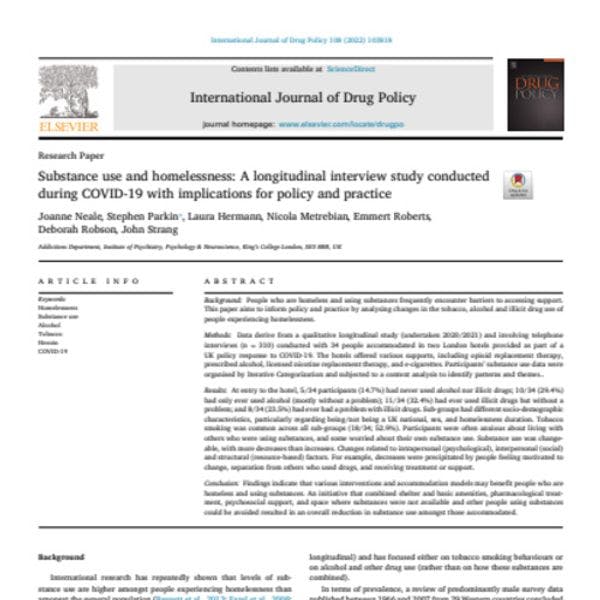Consumo de sustancias y personas sin hogar: Un estudio longitudinal de entrevistas realizado durante COVID-19 con implicaciones para la política y la práctica
Neale et al. destacan la diversidad de experiencias y la necesidad de ofrecer una amplia gama de intervenciones, incluyendo farmacoterapia, apoyo psicosocial y espacios seguros. Más información, en inglés, está disponible abajo.
By Joanne Neale, Stephen Parkin, Laura Hermann, Nicola Metrebian, Emmert Roberts, Deborah Robson, John Strang
Highlights
- Patterns of substance use amongst people who are homeless are varied and changeable.
- Men, UK nationals and people with longer homelessness histories use more substances.
- Substance use decreased amongst people housed in emergency hotels during COVID-19.
- Nicotine replacement therapy helped some people who were homeless to reduce smoking.
- People who are homeless want pharmacotherapy, psychosocial support, and safe spaces.
Abstract
Background
People who are homeless and using substances frequently encounter barriers to accessing support. This paper aims to inform policy and practice by analysing changes in the tobacco, alcohol and illicit drug use of people experiencing homelessness.
Methods
Data derive from a qualitative longitudinal study (undertaken 2020/2021) and involving telephone interviews (n = 310) conducted with 34 people accommodated in two London hotels provided as part of a UK policy response to COVID-19. The hotels offered various supports, including opioid replacement therapy, prescribed alcohol, licensed nicotine replacement therapy, and e-cigarettes. Participants’ substance use data were organised by Iterative Categorization and subjected to a content analysis to identify patterns and themes..
Results
At entry to the hotel, 5/34 participants (14.7%) had never used alcohol nor illicit drugs; 10/34 (29.4%) had only ever used alcohol (mostly without a problem); 11/34 (32.4%) had ever used illicit drugs but without a problem; and 8/34 (23.5%) had ever had a problem with illicit drugs. Sub-groups had different socio-demographic characteristics, particularly regarding being/not being a UK national, sex, and homelessness duration. Tobacco smoking was common across all sub-groups (18/34; 52.9%). Participants were often anxious about living with others who were using substances, and some worried about their own substance use. Substance use was changeable, with more decreases than increases. Changes related to intrapersonal (psychological), interpersonal (social) and structural (resource-based) factors. For example, decreases were precipitated by people feeling motivated to change, separation from others who used drugs, and receiving treatment or support.
Conclusion
Findings indicate that various interventions and accommodation models may benefit people who are homeless and using substances. An initiative that combined shelter and basic amenities, pharmacological treatment, psychosocial support, and space where substances were not available and other people using substances could be avoided resulted in an overall reduction in substance use amongst those accommodated.
